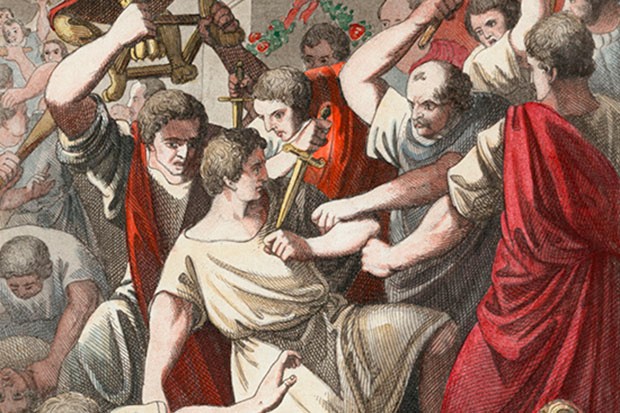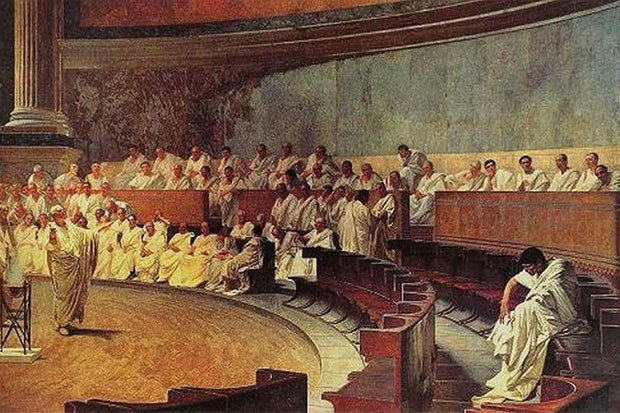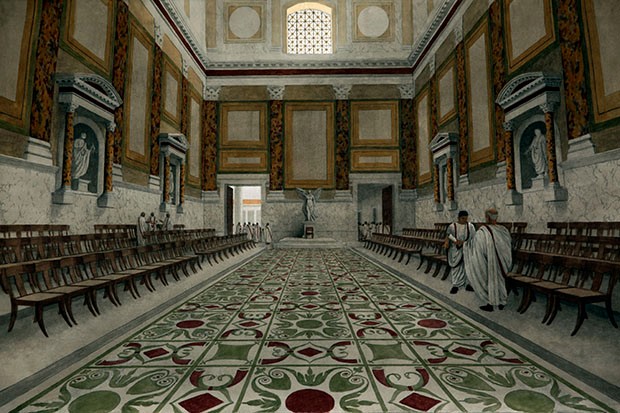The long death of the Roman republic
Julius Caesar’s murder is often seen as the event that ushered in the age of emperors. Yet – writes Shushma Malik – structural weaknesses had plagued Rome’s republic long before his death

Few events in the long span of Roman history were as bold or as shocking as the murder of Julius Caesar. On 15 March 44 Dc, in the consecrated space of Pompey's theatre, the life of the man who had come to utterly dominate Rome's political landscape in the middle decades of the first century BC was brought to an end in a flurry of assassins' blades. The repercussions for Rome and its expanding empire were immense.
Historians have been fascinated with the killing ever since – not just because of its audacity, but also because of what it meant for the future of Rome. When Marcus Junius Brutus and his fellow conspirators attacked Caesar on the Ides of March, Rome had been organised around a system of government called the ‘republic’ for almost five centuries.
Within 15 years of Caesar’s death, that republic had been transformed by a tidal wave of recriminations and civil war – to be replaced by the age of the emperors.
It is this very reason that Caesar’s death has been seen as a decisive break in Rome’s history: when one period came to an end and another – dominated by men such as Augustus, Nero and Hadrian – began.
Yet to ascribe the fall of the republic solely to the upheaval that followed the events of 44 BC would be a mistake. The republic was a system of government already under immense structural pressure from a range of forces, and those forces had begun pulling at the system's fabric long before the rise of Caesar.
The Roman Republic: A Glossary
Patricians: members of Rome’s aristocratic families.
Plebs: non-aristocratic citizens.
Consul: one of two annually elected chief magistrates who jointly ruled the republic.
Praetor: a magistrate whose role could include keeping law and order in the city, or taking charge of military affairs if a consul was away fighting.
Aedile: an official whose responsibilities included staging the Roman games and looking after public buildings.
Quaestor: a junior member of the senate responsible for looking after public revenue and expenditure.
Tribune of the plebs: an official elected to represent and protect the plebeian class.
Triumvirate: a group of three men holding power, such as the coalition formed by Octavian, Mark Antony and Marcus Aemilius Lepidus following Caesar’s assassination.
To understand the long roots of the republic's demise, it is first worth setting out what the republic was. Its name comes from the Latin term res publica, translated as 'public thing'. This signalled the fact that the business of the state was public property.
The republic was a system of government built around the idea of a mixed constitution, one that protected against the emergence of tyranny by ensuring that power could not lie with one person alone.
In practice, this meant that the highest magistrates, the consuls, were elected annually, and two men held the post at the same time. In order to reach the consulship, Romans would usually have to climb the cursus honorum (‘ladder of honours’), which started with the role of quaestor or tribune of the plebs, and progressed through the roles of aedile and praetor to the consulship. The idea of elite competition, in which the ‘best men’ (aristocrats) competed for the top jobs each year, underpinned, in the minds of some Roman historians, the republic's success.
But consuls were just one part of the equation of the republican government.

When the mixed constitution worked properly, power was balanced in a way that meant the magistrates, the senate, and the people had a say in ruling Rome.
The consuls, as the leading magistrates, had the right of military command and the power to summon the senate and the people. The senate, made up of Rome’s leading men, proposed and debated laws. The people’s assemblies – the democratic element made up of Roman citizens (always men) – elected magistrates, approved or rejected laws, and decided on issues such as declarations of war. Each part of the system was intended to balance the other.
More like this
That, at least, was the theory. The reality was far more grubby. From its inception, the checks and balances that the mixed constitution was supposed to provide were undermined by a chronic lack of accountability.
That was especially the case in the democratic element. Take the comitia centuriata as an example. In this particular people’s assembly, Roman male citizens were divided into groups of 100 men each, called ‘centuries’, to vote.
Yet not all citizens were equal: the wealthiest minority in society took up 98 out of the 193 centuries, while the poorest, most populous section of society had to make do with just five. This was not a system based around the principle of one man, one vote.
The weighting of the political system towards the wealthy few had profound implications for Roman society – not least the fact that it opened up the system to corruption. According to the first-century BC statesman and scholar Cicero, the res publica worked well when those in charge were looking out for the public good.
As Rome's anti-corruption measures show, politicians often used public office for private gain
But, as Rome’s long history of anti-corruption measures shows, politicians often used public office for private gain.
Another ingredient that posed a challenge to the Roman res publica was the fact that it was in a near constant state of flux, shaped and buffeted by a host of ever-evolving challenges, opportunities and threats.
In the second century BC, the historian Polybius described the mixed constitution as the source of Rome’s imperial greatness.
Yet that constitution did not appear fully formed in 509 BC (the year the last of Rome’s kings was expelled). Nor did it ever remain static in its almost 500-year history. One of the main voting assemblies, the concilium plebis (‘council of the plebeians’), wasn’t established until c471 BC after the plebeians refused to take part in military service until they were granted effective political representation.
There was a ban on marriages between patricians and plebeians until the lex Canuleia of 445 BC. And it didn’t become mandatory for one consul to be a plebeian until 342 BC.
The negotiation of power within the republic also shifted. The mid-second century BC saw two brothers, Tiberius and Gaius Gracchus, attempt to hold the office of tribune of the plebs for more than a year.
The Gracchus brothers earned popular support on the promise of distributing power more evenly across Roman society. They pushed through land reforms and sought to introduce laws against judicial corruption and extortion.
As it turned out, they overreached themselves – Tiberius’s attempt to win re-election for the year 133 BC sparked a riot that caused his death, and Gaius met a similar fate to his brother a decade later. However, their emergence forced a wedge between the office of the tribune and the other aristocratic members of the senate.
Among the factors driving the brothers’ rise was the rapid expansion of empire, and that growth’s destabilising effect on Rome’s imperial centre. One salient issue confronting Rome’s decision-makers was the question of how new people could be incorporated into the citizen body.
Since the early republican period, Rome had been expanding its territory out into Italy. Many Italians subjugated by the Romans were not offered citizenship, but at the same time they were expected to fight with the Romans as allied forces (socii). The socii were so enraged by this state of affairs that, in the 80s BC, they went to war with the Romans.
The so-called Social War resulted in the enfranchisement of most Italians. But this was not a quick-fix solution to Rome’s structural problems. The expansion of empire created vast inequalities allowing certain citizens to be- come extraordinarily wealthy, particularly those with extensive military careers.

One ancient historian, Livy, describes Lucius Aemilius Paulus returning from the Macedonian wars in 167 BC on a boat with 16 banks of oars, displaying to those who gathered along the Tiber his spoils of war, including a magnificent array of royal fabrics. Paulus donated some of these spoils to the public treasury, but spent the rest on public and private displays of wealth.
The emergence of a new class of super-rich generals not only supercharged the ‘wealth gap’ between the wealthiest and poorest in society, it also created disparities among Rome’s elite.
Men such as Caesar and Pompey – two of the most successful generals of the mid-first century BC – accumulated massive fortunes. This not only enabled them to buy political support by way of bribes, it also allowed them to use magnificent building projects and spectacular games to win the acclaim of the people.
Neither the evolution of the political system nor the expansion of the empire were, on their own, enough to bring down the Roman republic. But the combination of the two seems to have lit a match under Rome.
Rome had seen powerful individuals before the rise of Pompey and Caesar. Scipio Africanus amassed significant personal power following his defeat of Hannibal in 202 BC. So, too, did Scipio Aemilianus after the destruction of Carthage in 146 BC.
The difference was that the victories of Pompey and Caesar came at a moment in history when, while a select band of military men grew fat on the proceeds of their conquests, an increasing number of people felt left out of Rome’s imperial picture.
By the middle of the first century BC, such tensions began to manifest themselves in successive waves of political violence. In 52 BC, a former tribune of the plebs, Clodius Pulcher, was murdered after a brawl between his gang and that of his political rival, Milo.
Following Clodius’s death, his followers took his body to the senate house and used it as a pyre for his cremation. The building – which, according to Roman tradition, dated back to Rome’s third king, Tullus Hostilius – was burned to the ground.
The animosity between Clodius and Milo was in part caused by the fact that they supported rival political factions. The optimates, exemplified by senators such as Cicero and Pompey, believed in doing politics through the senate; the populares, with Caesar to the fore, preferred to take their policies straight to the people.
The violence between Clodius and Milo would soon be overshadowed by another, more consequential, outbreak of internal unrest. In 49 BC, tensions between Pompey and Caesar reached boiling point and erupted into a full- blown civil war, with the latter famously crossing the Rubicon and marching on Rome.
As a select band of military men grew fat on the proceeds of their conquests, more and more Romans felt left out
This clash has been portrayed as the product of the ambition of individual men, but the instability of the previous decades suggests that it was also a result of political and social shifts in Rome’s widening empire.
After Caesar had inflicted a conclusive defeat on Pompey at Pharsalus in 48 BC, the politicians who supported him squeezed the system further still, by giving him the title ‘dictator perpetuo’ (dictator in perpetuity). The role of dictator was a constitutional one, which had its roots as an emergency office used during the Roman republic to deal with situations of extreme danger (such as enemy attack).
But Caesar used the office to separate his power from that of other magistrates. The taking of the title in perpetuity was, according to the second-century AD historian Cassius Dio, the final straw for Caesar’s enemies. Two months later, he was assassinated.
After Caesar's death on the Ides of March, the conspirators had envisaged a return to the republic. But it's not necessarily the case that this republic embodied the principles of the mixed constitution with its checks and balances intact.
One of the most famous pieces of material evidence that remains from this period is the ‘Ides of March’ coin. On the coin’s reverse side are images related to Caesar’s killing – daggers and a ‘pileus’ cap representing freedom (shown above).
Just as important, however, is the obverse of the coin, which features a bust of Marcus Junius Brutus. Living individuals were not portrayed on coins in the republic – this was an honour reserved for gods and revered ancestors.
Julius Caesar was the first to break with this tradition in 44 BC, minting a coin with his bust on the obverse and the legend ‘Dict(ator) Perpetvo Caesar’. Now Brutus was doing the same.
That he did so, following in the footsteps of the man he’d helped assassinate, emphasises how attitudes to representations of individual power had changed. In the republic as imagined by Brutus, there now seemed to be space for this new articulation of aristocratic status.
But Brutus did not manage to restore even this revised version of the republic. In 43 BC, Caesar’s killers were outmanoeuvred by Octavian (Caesar’s adopted son), Mark Antony (Caesar’s co-consul in 44) and Marcus Aemilius Lepidus, who formed a triumvirate that afforded them extraordinary powers.
The so-called triumvirs used that power to make and annul laws, appoint magistrates, command armies – and hunt down the conspirators. After suffering defeat at Philippi in 42 BC, Brutus and his fellow conspirator Cassius both fell on their swords.
But then the triumvirs fell out with each other. In 36 BC, Octavian forced Lepidus into retirement and then went to war with Antony, triumphing over his erstwhile ally at the battle of Actium – a victory that led to Antony’s suicide (and that of his lover, Cleopatra) in 30 BC.
By the time Augustus died in AD 14, the mixed constitution that characterised the republic had all but disappeared
Octavian was now the last triumvir standing. He held a triple triumph in Rome in 29 BC, and then in 27 BC, in recognition of his power, the senate conferred on him the title ‘the most revered one’: Augustus.
In his Res Gestae, the inscription erected outside his mausoleum to record the achievements of his reign as Rome’s first emperor, Augustus would claim that he restored the res publica after Actium. However, retrospect makes it clear that, by the time he died in AD 14, the mixed constitution that characterised the republic had, for the most part, disappeared.
It was Rome’s second emperor, Tiberius, who formally transferred the powers of the voting assemblies to the senate. But Augustus had already begun to undermine their role by proposing his own candidates for the magistracies (adlection).
The senate retained its role as a body that administered the empire, with most provincial governors chosen from among its ranks, but the emperor took over matters of policy.
Because the Roman political system had always been subject to reform, Augustus could frame these changes as natural ones that responded to the social and political needs of the time. And he did so using a rhetoric that claimed the spirit of the republic still lived.
The problem, of course, as the historian Harriet Flower has pointed out, is that the political reality was not of one republic, but rather a series of Roman republics, in which evolving political situations necessitated a continual re-imagining of the relationship between individuals, aristocrats and the wider Roman state.
According to Augustus, his re-imagining merely took this evolution one step further. The result was the rise of the imperial Roman principate.
Shushma Malik is Onassis classics fellow at Newnham College, University of Cambridge. Her books include The Nero-Antichrist: Founding and Fashioning a Paradigm (Cambridge, 2020). Accompanies the BBC Two series Julius Caesar: Making of a Dictator
Authors
Shushma Malik is Onassis Classics Fellow at Newnham College, University of Cambridge, and author of The Nero-Antichrist: Founding and Fashioning a Paradigm

Start the year with a subscription to BBC History Magazine - £5 for your first 5 issues!
As a print subscriber you also get FREE membership to HistoryExtra.com worth £34.99 + 50% London Art Fair 2024 Tickets




